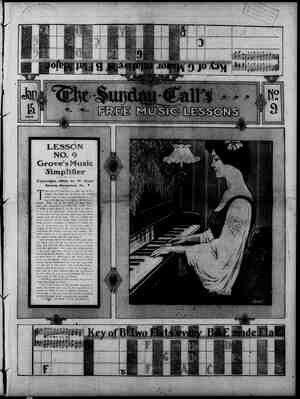The San Francisco Call. Newspaper, January 15, 1905, Page 1
You have reached the hourly page view limit. Unlock higher limit to our entire archive!
Subscribers enjoy higher page view limit, downloads, and exclusive features.
LESSON NO. 9 Grove’s Music Simplifier Copyright, 1904, by W. Scott Grove, Scranton, Pa. ¢ HE key of B flat has two flats, and in this lesson, the ninth of the series, the charts: show how to play accompaniments in the key of B flat and its relative, tife key of (i minor. -Place one of the charts at right ‘angles with the keyboard, so that the small letier D with a dash above it on the chart is directl: over D on the keyboard. Then the white spaces on the chart will be over the white keys and black spaces ovet the black keys. The top, middle and lower sections on the lower chart represent the three chords, a mastery of which will enable any one to accompany op the piano any song or melody in the key of B flat. and the upper chart represents the chords of the key of G minor. The black letters are to be played with the left hand. the colored letters with the right hand.® Now having placed the cl on the piano, play the, black letter on the top section with the left hand and then the three colored letters in unison with the right hand. ‘Next play the middle section in the same way, then the lower section and then -return to the top section. The small letter D with a dash above it, which gives the chart position, must not be played. After.a brief practice these 5 can be memorized atid you may play with- out the use of the chart. But with.the chart a person who never struck a note on the pigno be- fore may in a few minutes play the harmonious chords correctly and then accompany his or her own songs or the songs of friends. Proficiency requires a little practice, but no pre- vious knowledge of music. i you wish to delve deeply into the mysteries of music the charts give you the best possible foun- dation on which to base a masical education. A knowledge of the keys and their ‘chords underlies all the triumphs of the accomplished musician. (TENFH LESSON NEXT SUNDAY.)
